Guide to buying second hand fishing tackle
This seasonal cold and wet weather can cause many of us to stay at home rather than go fishing, but the yearning within to do something fishy can often be satisfied by buying more kit.
I have been buying second hand tackle for the last 30-odd years. In the ‘olden days’ the only way you could buy used gear was to visit car boot sales, read adverts in newspapers, check out ‘For Sale’ notices in shop windows, or go by word of mouth. These days it is almost all done online.
I must admit that, although I think I have more often bought wisely, including some absolute gems, there have been a few times when I have bought complete stinkers. Here I hope to give an insight into my own experiences, pass on lessons I have learnt and try to outline the benefits and potential pitfalls of buying second hand stuff hoping both to entertain and enlighten along the way.

I am living testimony that buying second hand stuff can be a way of life. On most days lately the only item of my clothing that didn’t come from a charity shop is my underwear – the same is also true about my fishing tackle!
The set-up in the photo is my usual river gear. The box is second hand, as are the two 13’ Acolyte rods, the 17’ Acolyte rod, all three closed face reels and the pole spray bar. By going into transactions like these with our eyes wide open and with a little bit of understanding we can all buy ‘champagne’ tackle for beer money prices.
The case for the prosecution
Buying Online
There are an increasing number of online platforms where you can buy and sell absolutely anything. For fishing tackle my own primary sources are eBay and sometimes Facebook marketplace.
If you choose to buy online you need to be aware that not every platform has worthwhile in-built buyer protection. Facebook marketplace, for example, sometimes causes problems for both buyers and sellers in my opinion. You may find it suits you, but I believe that there is very little opportunity for returning a faulty item. It all comes down to trust. It also seems to me that there are no ‘formal’ or legally binding rules that are applied, and if there are such rules I have evidence that they are not enforced. I know both buyers and sellers who bemoan the frequency with which a transaction has gone awry and they have been unable to resolve to any level of satisfaction.
By far the most popular forum for buying second hand tackle for me is eBay, with good reason. The feedback system and customer complaints process can virtually eliminate the possibility that a buyer will be ripped off. If buyers also use PayPal to pay for goods they will be doubly protected. PayPal always favours the buyer in the event of a dispute, meaning there is very little chance that they will end up losing out. PayPal withholds the funds for a period and will ensure that the seller cannot renége on the deal and then do a disappearing act.
There is a selling platform called Pre-Loved, and that phrase ‘pre-loved’ is at the crux of buying anything secondhand. We bargain hunters all hope that, as we pay our very low bargain-price, we are truly getting something that was actually pre-loved – and not some old tat that has been thrashed to bits and is going to fall apart the first time we put it through its paces.
Caveat Emptor
Caveat emptor means ‘buyer beware’ and there will be those out there who will simply never even consider buying second hand fishing tackle. The number of scoundrels in society seems to be multiplying exponentially in these days of enormous inflation and increased hardship. It seems it can sometimes be difficult to find an honest seller. It’s a dog-eat-dog world and for some people they will simply always stick to buying brand new because they find reassurance in being able to return a faulty item from whence it came knowing that there is safety in a warranty.
Due diligence
Before you run off as fast as you can to buy a used bargain I feel I must announce a big disclaimer. There are a multitude of reasons why an individual might sell an item of fishing tackle and whilst the majority of sellers are solid trustworthy individuals there are a few out there who are not. Take precautions about buying from the latter, and hope that you are dealing with the former, because the traditional maxim ‘caveat emptor’ never rang truer than it does these days.
Please remember vendors are not your friend (even if they actually are your friend), they are almost certainly not experts in carbon-fibre or in fishing-reel technology, and they are usually not doing you a favour – they are quite simply trying to make money from something they no longer want or need.
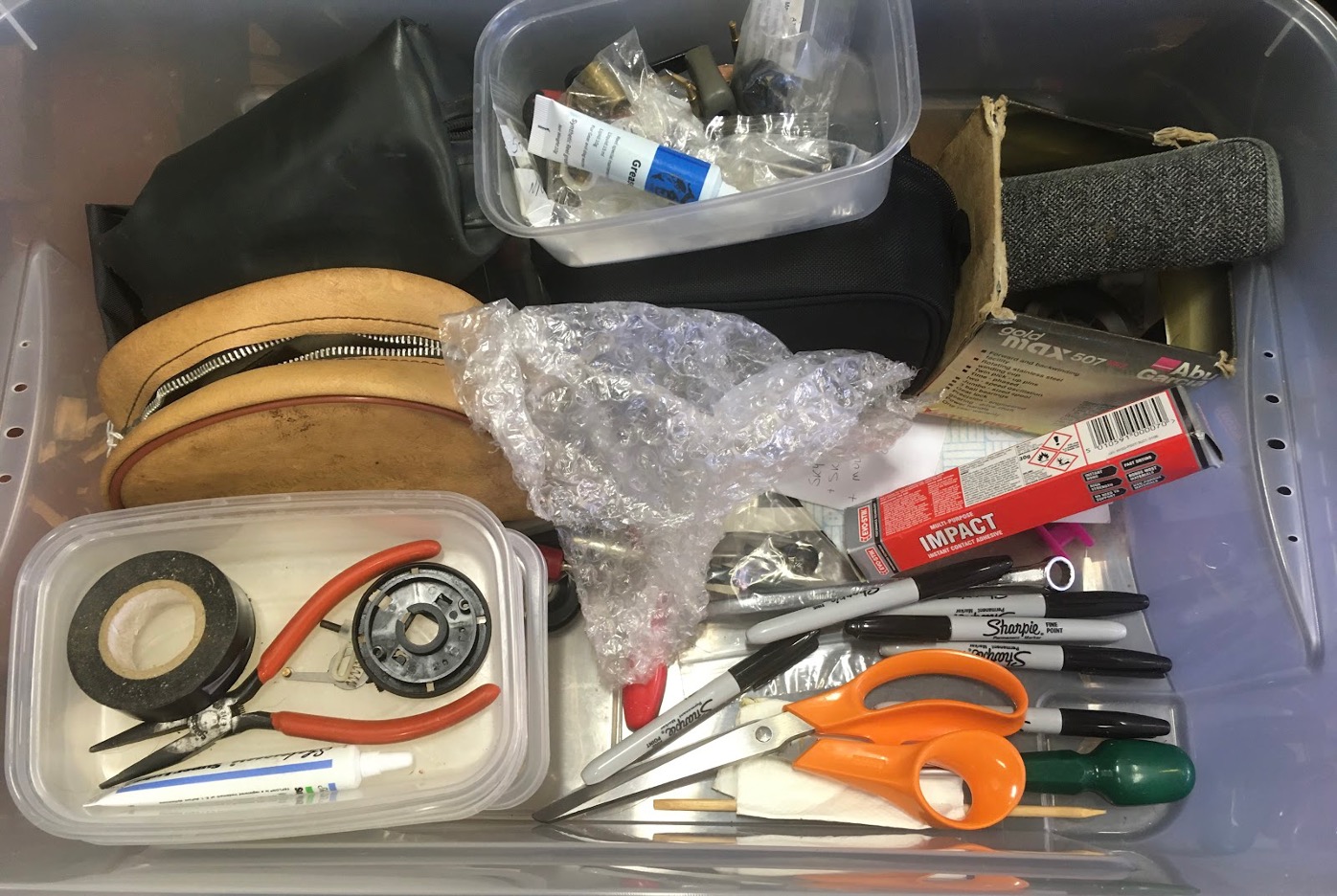
Buying second hand fishing reels is always easier if you are confident that you can repair and service them if they prove to be broken. This is my reel repair box which is packed underneath with spares, tools, and lubricants. Most recently I have been servicing my Goldmax 507 reels, and if you read on you will no doubt discover why a Shimano Stradic is next on the agenda.
So, the onus is always on you, the buyer, to do your own homework, check the product, and personally ensure that you take every precaution as far as is reasonably practicable. If you do all that you will find there are still genuine bargains to be had. If you think you are getting a bargain just take a second or two to make sure. There most certainly are bargains to be had but don’t let that make you complacent. Check once, check twice and then check again!
You get what you pay for
Another reason many anglers might shy away from second hand tackle is the old adage, ‘you get what you pay for.’ Except that’s not quite correct as far as I am concerned. The price you pay can often reflect many things completely unrelated to the item for sale.
The truth is that the price the vendor sets for brand new items as well for used doesn’t actually truly reflect the amount of effort or the materials that are required to produce them. Realistically it merely reflects the amount of profit that the vendor considers that they can get for it. It’s the reason the price of holiday breaks go up in price during school half terms – they haven’t improved the quality of the caravan or hotel, they just know you will pay more because of supply and demand.
When a vendor can make a heap of profit that’s exactly what they do! However, the price can always be haggled over, especially for a cash deal. Don’t be shy – if you think an item is overpriced just offer a little less. What’s the worst that can happen?
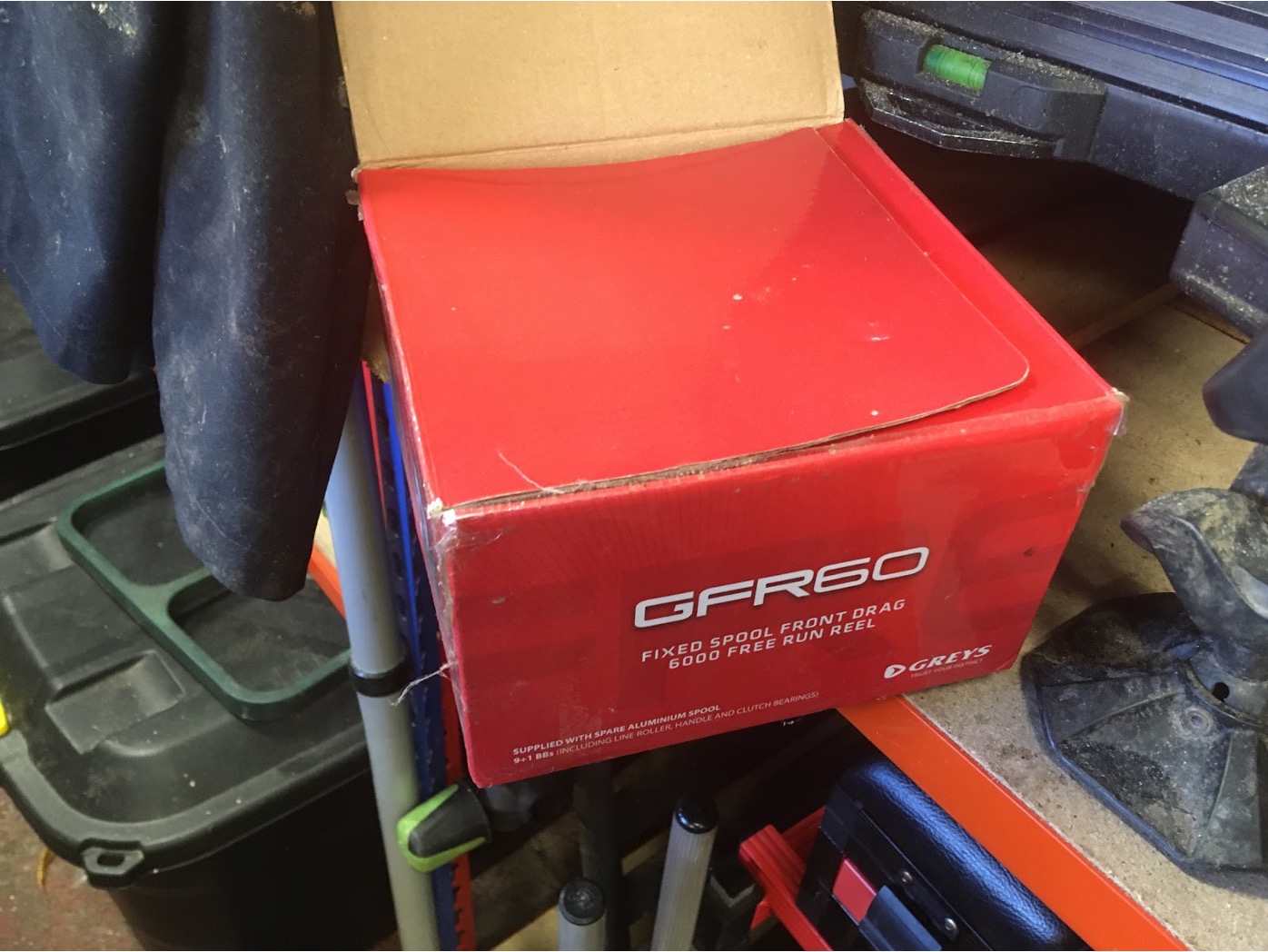
In this box lurks a Greys reel. It has a free spool facility which many of us refer to as being a ‘baitrunner’. Unfortunately it isn’t a genuine baitrunner because that terminology can only be applied to a Shimano free spool reels.
Shimano made the first baitrunner, and in my opinion they probably still make the best baitrunner. So, if you want to buy a free spool reel buy a Shimano baitrunner, not a cheap imitation baitrunner made by Greys. Especially one that has a spring in the anti-reverse mechanism that perpetually keeps popping out of its correct location rendering the reel useless. I wonder if the person who sold me this particular lesson in life knew it wasn’t worth the price I paid?
Where does second hand tackle come from?
Tackle Tarts: Buy in haste – repent at leisure
We all know the old saying ’buy in haste and repent at leisure’ which reflects how easy it is to spend money but much less easy to recoup it. It’s that lesson that buyers of used gear need to concentrate on because it defines a subspecies of angler with too much money and a lot less sense and they are the perfect angler to buy from. Ladies and gentlemen I give you the tackle-tart.
There are loads of ‘tackle tarts’ out there with far too much money to burn. They have to have everything new or have to possess the latest model. They enjoy nothing more than the one-upmanship of having the latest gear, and if possible they want to possess it before everyone else. Trouble is, to afford their passion, they often have to sell stuff to buy the new gear. If they are lucky they are rich or they come into a little money, either way it flows through their fingers like water. Well hooray for them, I say. They are a bargain hunter’s dream. The natural target prey of the second hand tackle buyer. The absolute best people to buy from!
Tackle tarts buy new, polish it every night after they use it and then replace it as soon as the new range for next year is marketed. Buying tackle from these anglers is always going to be a pleasure. The gear will be super well looked after, rarely more than a year or so old and really worth buying.
Death and taxes: two unavoidable facts
Another deep well that is primed for producing bargains belongs to a particular type of vendor on such platforms as eBay. They are the ones who buy job-lots and break them down into individual lots. It takes a while, but regulars to eBay will soon spot the tackle vendors who are regularly selling a stream of ’big stuff’ such as seat-boxes, poles and rods, etc. and all their photos have the same background.
Often the photos are taken outside in their back-garden with the back-drop of exactly the same decking and fence. Ostensibly they may appear to be selling their own gear but upon closer inspection it can be seen that these are private individuals who will buy a complete job-lot set of tackle, often from the family of an angler who has passed, for a reasonably low price and then they sell the gear as individual items.
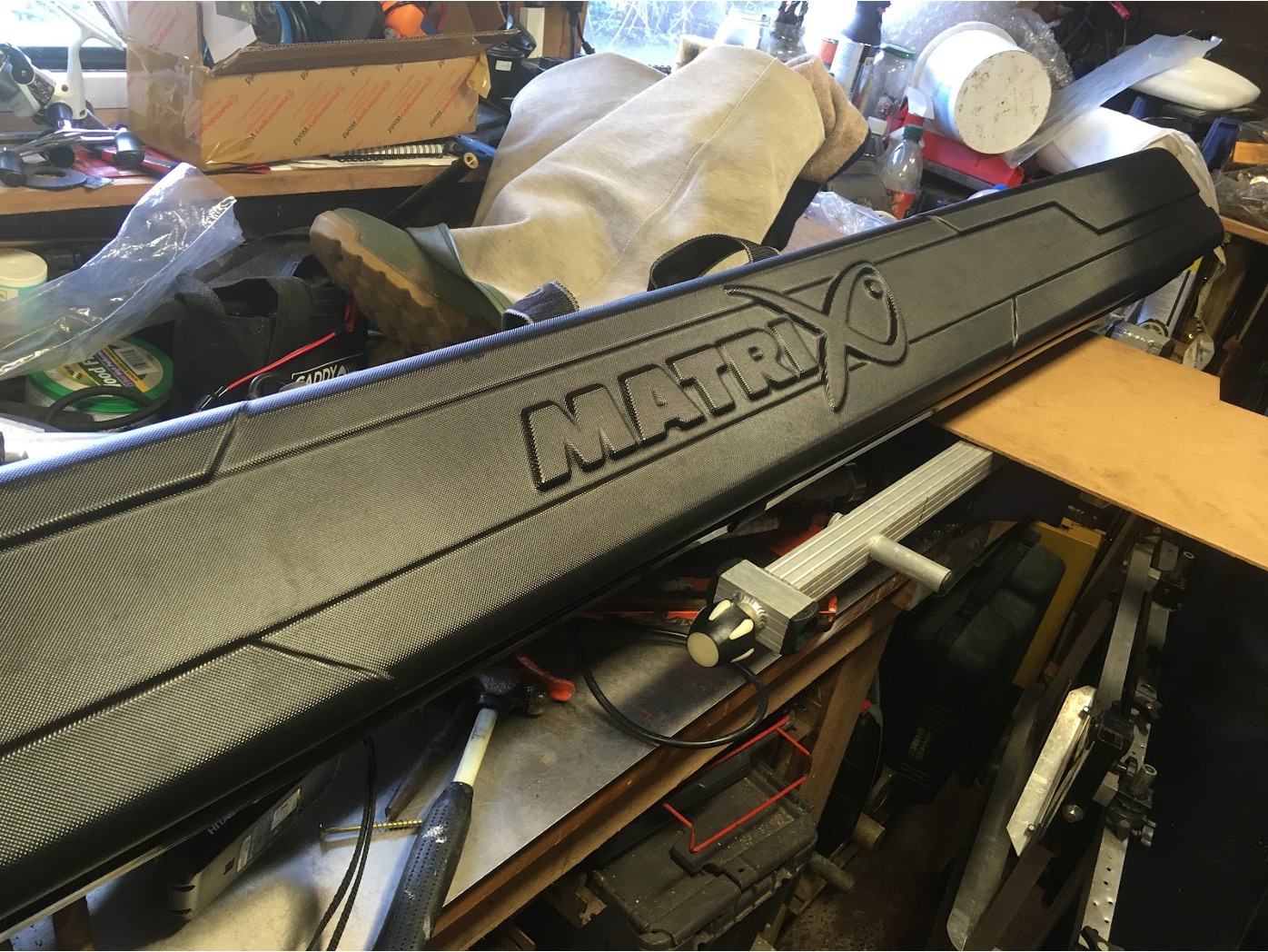
A matrix hard-case recently purchased locally through a guy on eBay, one who I frequently buy from. You wouldn’t believe the bargain price I paid for this, and it is absolutely mint. This was a great ‘win-win’ because the seller gets a quick turnover and also receives my cash straight into his hand, at which point both parties ride off into the sunset happy and ready for the next transaction.
I have several of these types of vendors saved in my eBay account and always try to buy from my regulars. I also know two local people who buy job lots and sell fishing tackle regularly on eBay. One I consider a friend who does it as a side-line and for the other it is a primary source of income. It is a great way to make some money for the vendor and an equally great way for a buyer to get a bargain.
Whether it is a main source of income or a sideline, the eBay vendor always wants a quick turnover and doesn’t want to be left with a shed bursting at the seams because it’s full of unsold tackle. Always haggle with these people if you can. They will always respect an offer because they want to avoid a huge stock buildup and in consequence everything must go.
One of the slightly macabre factors here is that the tackle that ends up in job lots has very often had very little use. An angler retires, needs a lighter seat-box or a better pole to ease his back pain, or they think they deserve some new stuff as a reward for their years of service. Either way, they buy in haste and then never actually get to use the stuff before Tempus-Fugit catches up with them, at which point the family is left with the problem of what to do with all this tackle, hidden in the shed – so much virtually brand-new stuff they never knew he owned!
Go to your local tackle shop
Another place where secondhand bargains can sometimes be picked up from is your local tackle shop. That’s right, look into the recesses of the shop and you can often see an item that the shop owner is selling for a customer. My local tackle shop sadly closed down during the Covid pandemic and I had used it for nigh on 40 years.
The owner is someone I still consider a friend and he would often tell stories of people who had retired and who decided that their pension lump-sum was better spent on fishing tackle, (purely to ensure that retirement was as much fun for them as possible, you understand.) Once the madness had passed they were dragged kicking and screaming back to the tackle shop by their significant other, asking my tackle dealer mate if he would sell some of the stuff to recoup the money. He obliged, because he is a nice guy, but as he wasn’t really making any money he always made sure he was free to sell for a ‘reasonable’ sum.
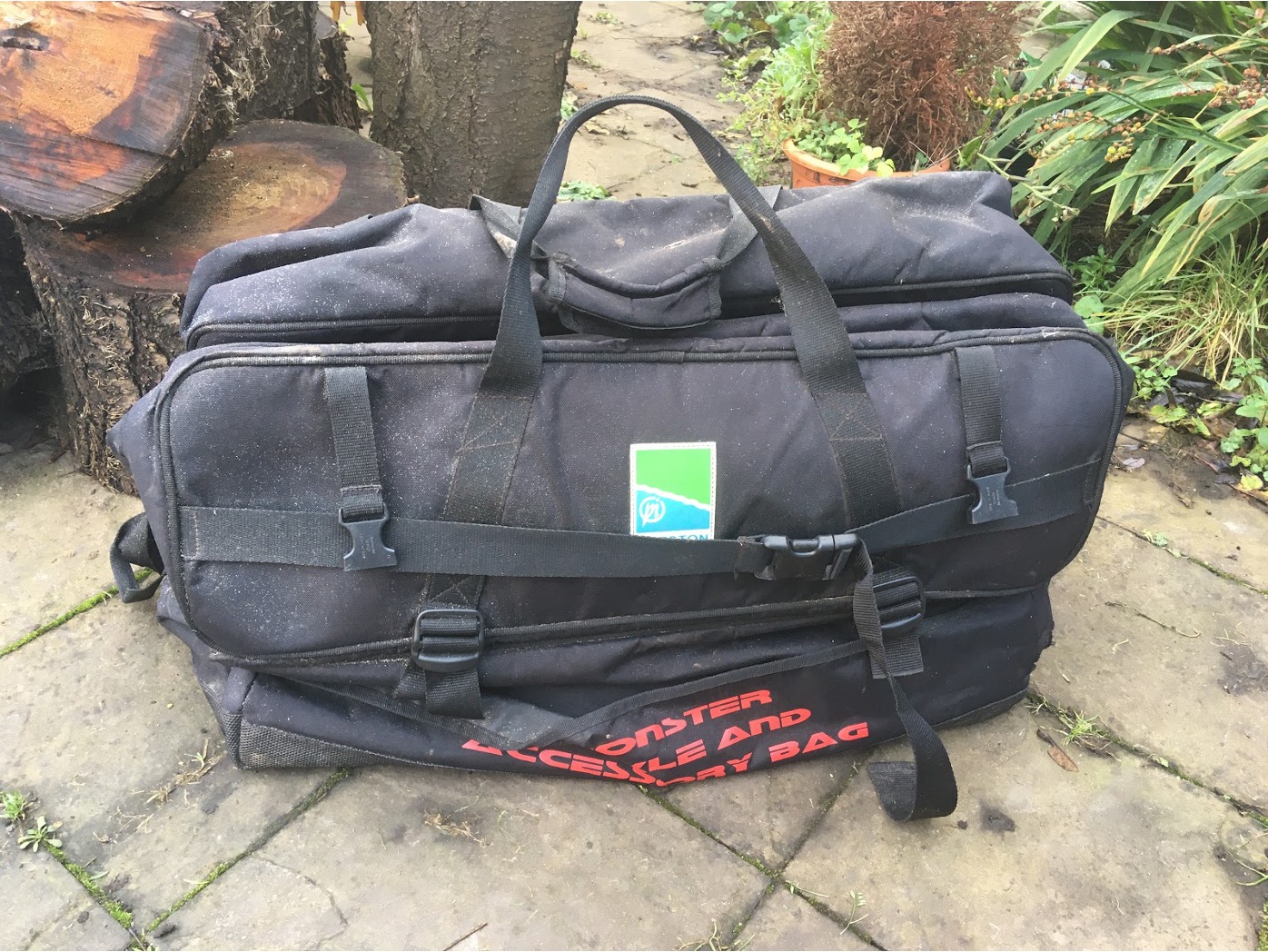
When I bought this from my local tackle shop it was absolutely ’as new’. I seem to remember the story behind it was that the owner bought it, couldn’t get along with it, and asked if the shop would sell it for him. There was a load of other returned gear from the same person around the same time. Never forget – ‘Buy in haste, repent at leisure’.
I also recall the story of a lottery winner who came into the shop saying “I’ll have that and that and that!” Having spent thousands on his fad the lottery winner returned much of the stuff at a knockdown price about a year later, much of it still in its original wrapper. As previously stated, and I know it’s getting repetitive now – ‘Buy in haste, repent at leisure’.
General guidelines to buying second hand fishing tackle
- Don’t buy in haste. Check out as many options as you can before finally selecting the item you are going to buy. There is always another just around the corner.
- If you are in an auction try to decide your maximum bid and stick to it. Don’t be tempted to increase your bid at the last minute. If you couldn’t commit to paying more before the auction began then why would you be prepared to pay more at the end?
- Create a PayPal account and try to use it to make your purchases. PayPal always protects the buyer so if there are any issues with the item after the deal has gone through you can invariably claim a refund.
- If the seller refuses PayPal then ask yourself ‘why?’ If you decide to forge ahead despite not having buyer protection on your side, proceed with extreme caution.
- If paying with cash you must again proceed with caution. Inspect your purchase thoroughly before you hand over your money as getting your cash back is likely to be somewhere between very difficult and utterly impossible.
- Try to avoid having the item delivered to you personally by the vendor. This particularly applies to buying on Facebook and Gumtree etc, where the deals are sometimes local. It is very easy for the vendor to beat a hasty retreat with your cash and you may have no idea where to go for your refund if you have a complaint. Always go to the vendor’s home address to collect if you can. Knowing the address may be advantageous if there is a dispute.
- If a deal feels dodgy it probably is. Walk away.
What to look for in ‘Big Ticket’ items
We can all make mistakes sometimes when buying goods. This can even happen when buying brand new, so can certainly happen when buying used. However, it’s not really a significant problem with cheap items as the risk is diminished, so it only comes to the fore when an item commands a higher price. There aren’t many of us who can’t afford to lose a fiver on something, easily putting it down to experience, but are you prepared to gamble with five hundred quid? Not me!
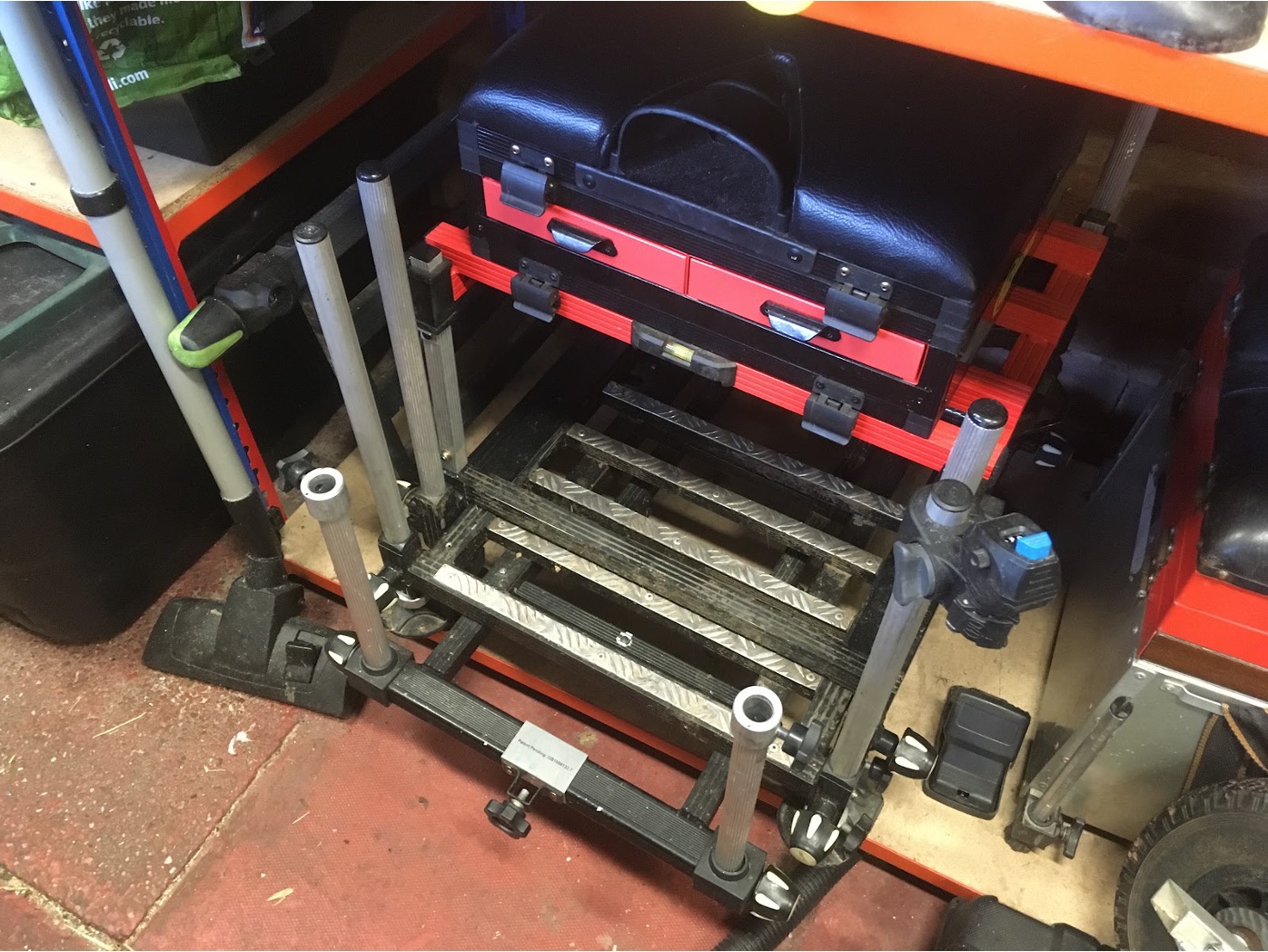
Although I bought a brand-new Brilo box in the late eighties and another brand-new Preston Inception box about five years ago I now use neither. Indeed the Inception has been sold on. I now have several different seat-boxes and all of the ones I now use were purchased secondhand. This photo shows my ‘used’ box from Nordik Tackle (Oct box) and it is simply the BEST box I have ever owned. If I were a seat box maker, as an engineer, this is the box I would make. I got this one for such a low price that I broke the speed limit as I drove away. It is now much modified and I have refurbished multiple bits on it, but it was still the absolute bargain of the century. I love it!
The heavy hitters are the deals that nobody wants to get wrong and there are a few ‘Big Ticket’ items in fishing tackle that I will talk about individually. There are plenty of small items to be bought that are not really expensive enough for me to talk about, so here are a few categories that deserve mention.
#1 Seat Boxes – buying second hand fishing seats
A seatbox is a very personal thing. I am going to assume that you have seen a design you like, tried it in the shop or admired one on the bank and that you are certain that it is what you want.
- Before you buy check every leg to ensure it adjusts fully and doesn’t slip.
- Don’t forget to check the telescopic inners.
- Apply your full body weight if you get chance to ensure the legs don’t slip.
- Establish that you can get the height adjustment correct.
- Make sure the mud feet are in place, firmly fixed, and that they swivel correctly.
- Check the seat for rips and cuts.
- Ensure the foot-rest slides in and out and locks positively in both positions.
- Make sure drawers stay put when closed especially when loaded.
- Check that the drawers slide easily.
- Pull out the drawers and inspect them to make sure they are undamaged.
- If the box has stacking modules make sure they do stack.
- Ensure all fasteners work and that there are no latches, locks or clips that are broken.
- Make sure that any carrying straps work properly and that you can actually get the box onto your shoulder without too much difficulty.
#2 Poles – buying second hand fishing poles
Poles can be tricky to inspect, so beware. Firstly ask the seller if there are any problems. If they say that there are none then you are quite within your right to return the pole or negotiate a significant discount if you find any flaws. Personally I would only buy a pole face to face directly from the vendor, going to their property to inspect, and only paying once I was certain that the item matched the description. One hears of disputes where the item is damaged in transit and the ensuing argument about whose fault it is can get a bit tasty. These disputes are usually sorted out fairly in the end but who wants to put themselves through that drama? Not me.
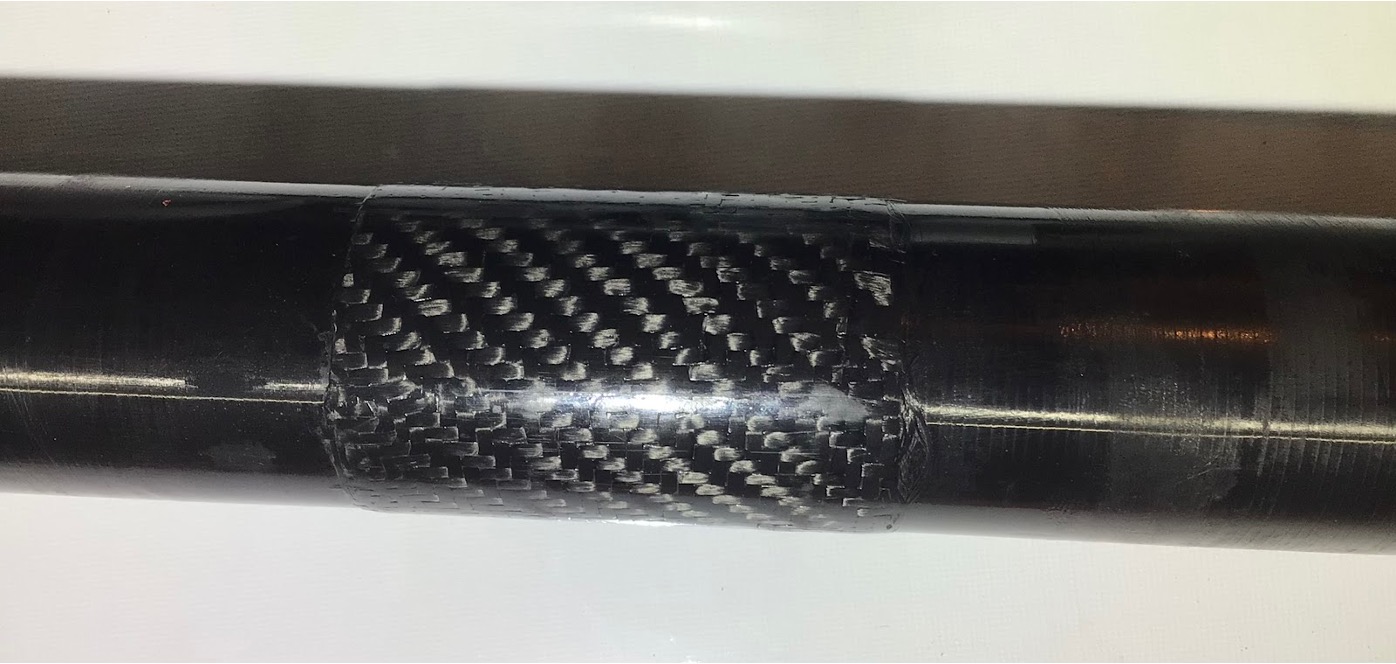
This is the number 7 section of my Garbolino pole. I broke it myself and had it ‘professionally’ repaired. The pole performance is identical to the way it performed before I broke it, so I can assert that it should be worth the same money. Even so, I know with absolute certainty that its value has been diminished. If I were to be buying it second hand myself I would definitely negotiate a discount because of the repair and if I didn’t get one I would walk away. It’s not fair but it is a big advantage that a buyer has. Use it!
There are certain pole sections that will always take the brunt of a heavy-handed angler’s use. Generally the larger sections may have end damage due to being shipped back into something hard like a fence-post or across a gravel path. In addition to inspecting the ends, run your hand carefully along every section giving a gentle squeeze as you go. Rough handling will sometimes cause hairline splits that are not obvious to the naked eye. A gentle squeeze may reveal a slight ‘give’ that goes visually unnoticed or in some circumstances you will even hear the carbon creaking.
** CAUTION: Do not squeeze too hard. You will be in a right pickle if you manage to crush one of the sections with the vendor watching. Your aim is to detect damage, not cause it. Many poles these days have really thin walls and although reinforced at the points where you normally handle them they are not designed to resist excessive force elsewhere.
By rotating the pole section and squeezing several times in every position you may reveal issues that at first remain hidden. This is because some fractures will only be revealed in certain positions. Because every pole needs to be broken down when playing and landing a fish, and in some instances an angler may break down one section at a time, there is clearly a possibility of damage occurring on any section and anywhere on that section. However you must pay particular attention to the large diameter ends of all the top sections and also pay particular attention to No 3, No4 and No 5 sections as these are most often held when fishing short. Fortunately many poles these days come with multiple top twos and also multiple number threes and fours.
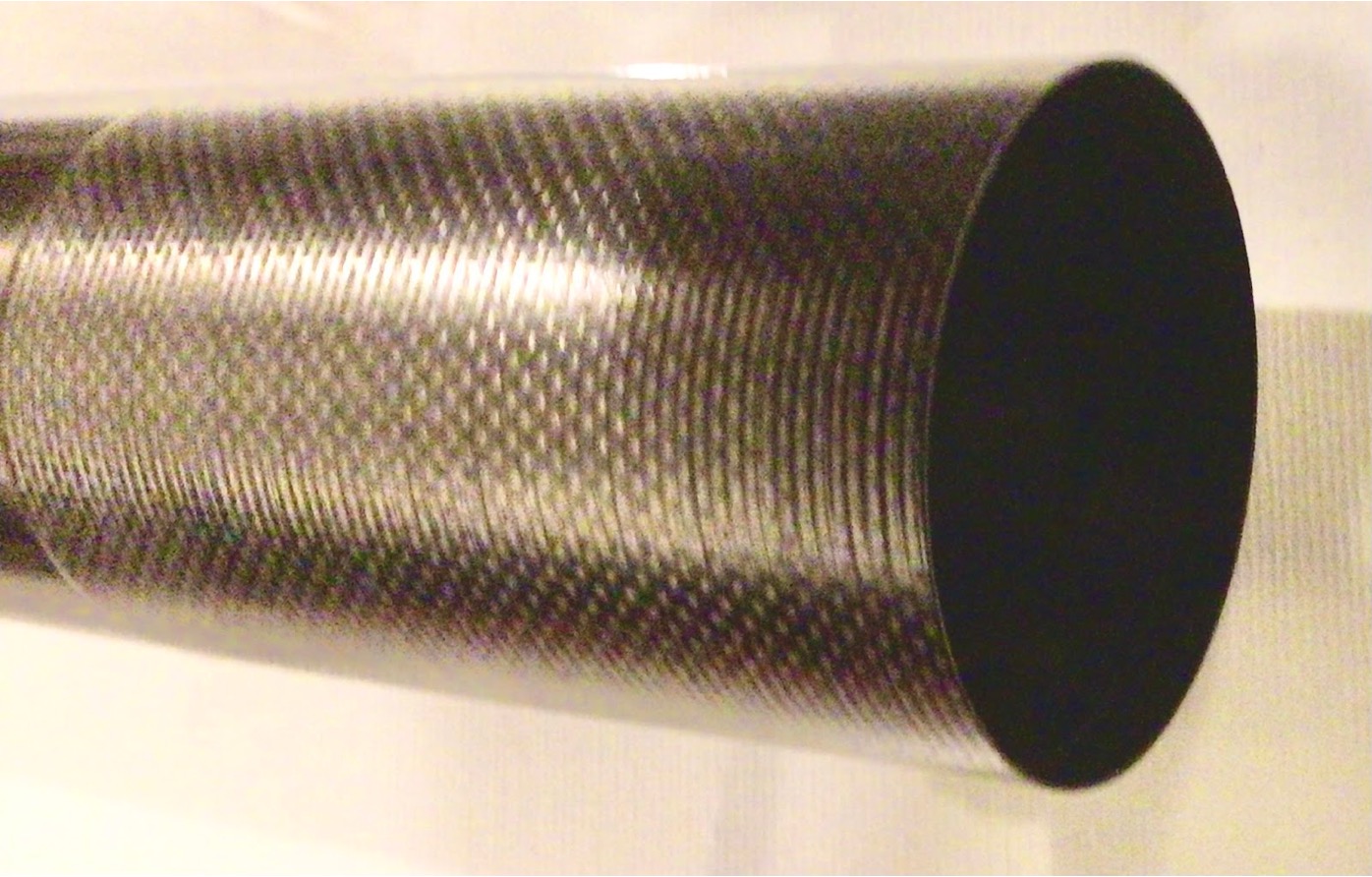
This is what the ‘fat end’ of every section of a pole should look like. Crisp, sharp, and perfectly undamaged. If there is even slight evidence of damage you should demand a discount. Remember, the section may be perfectly usable even when damaged and the vendor may try to use that as a reason not to budge on price, but a potential splinter of carbon fibre up the quick of your fingernail is a mighty persuasive argument.
My own Garbolino, purchased second hand, came with eight top threes, six number fours and three number fives and even two number sixes. This number of sections means that the odd section that creaks may not be a deal breaker but it is certainly a great bargaining chip to negotiate a bit of money off, especially if you show the vendor that you have discovered a problem that they had not told you about beforehand.
Finally, put every section together at every joint, in every possible combination, ie. put every No3 onto every No4, etc. down the entire pole. This allows you to inspect the joints for wear as well as checking that they also come apart. Don’t be rushed. For many anglers a pole is their single most expensive item of tackle and it deserved a ‘good coat of looking at’ before you buy.
#3 Rods – buying second hand fishing rods
All fishing tackle is very much a personal choice and rods are no different. In fact, because some angling disciplines require a rod to be handled for protracted periods, it is no surprise that many tremendous rods get relegated to the bench by some. A perfect rod for one might be slightly too soft for another, a handle length may perfectly suit Jack but be too long for Jill. It is easy to see why rods so frequently become available as second hand bargains.
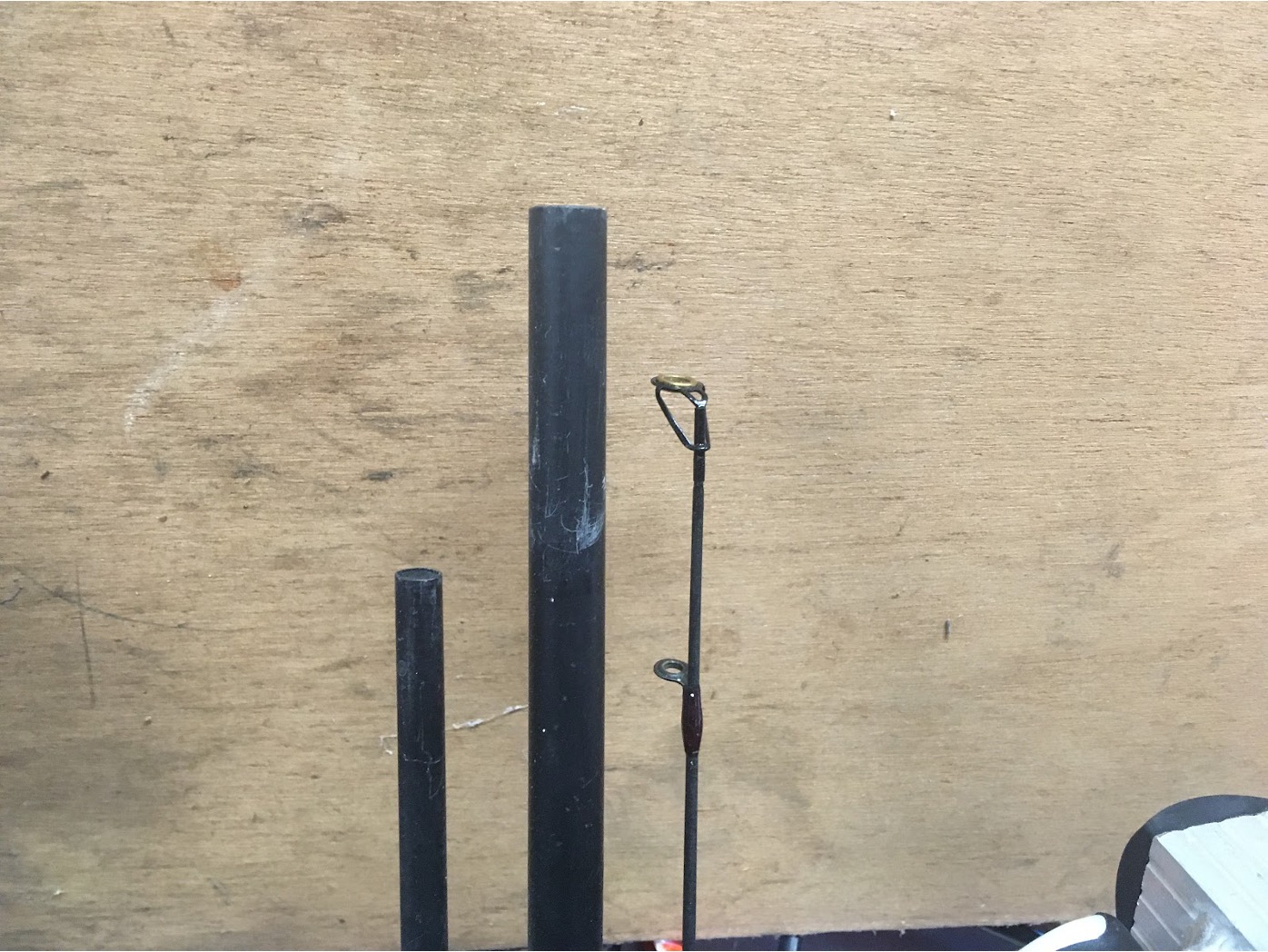
Generally you will find that all the sections of a finished rod are identical length. This three piece rod has three sections all of different lengths. The end of the tip section lost the tip ring along with an inch or so of carbon, and the middle section was snapped in two by the same dirty great hoof that broke the tip.
The photograph shows my personal barbel rod which I have repaired and which still works fine. Although it is not for sale, I would be remiss if I ever tried to sell it without explaining where the missing bits of carbon were. As a potential buyer you should make sure you are paying the ‘broken and repaired’ price and not the ‘don’t worry it was made that way’ price… because it wasn’t made that way. If it is cheap enough there isn’t a thing that cannot be sold.
Most second hand rods will be in excellent condition and well worth considering but that doesn’t mean a prospective buyer shouldn’t go through a set routine of checks, just in case.
- Assemble the rod and carefully inspect every joint.
- Does it slide together easily and do the joints then stay tight?
- Does it also come apart without too much effort?
- Are the rings all perfectly aligned when you look along the rod?
- Pay particular attention to any abnormal ring.
- When you inspect the whippings are they all identical? You should spot a repair.
- Is the varnish around all the rings in pristine unrepaired condition?
- Does the reel seat work? Does it stay tight and hold the reel firmly?
- Are all sections of identical length? Sections are rarely made to different lengths.
- A broken tip may only be revealed by a missing inch or two.
- Are the male and female parts of each joint free of damage and scratches?

This is a bit left over from a broken 17ft rod. The rod has now been repaired and if you weren’t told that it had been repaired you possibly would not be able to tell unless you held it adjacent to a perfect example. I have both a perfect example of my 17’ rod, and also the repaired example, and I can assure you that they cannot be told apart during use. However, there is a good eight inches of carbon missing from one, which means that the sections are invariably of uneven lengths. So, if you were buying this rod, would you be able to investigate sufficient to ensure that you knew what you were buying? Caveat Emptor.
A buyer needs full disclosure from a vendor. Any departure from being perfect may indicate that a repair has been undertaken, a repair which you will want the full information about. Don’t be too put off if a ring has been replaced as it is easy to bend/break a ring when regularly handling a rod. If an inch or so is missing from the tip of a rod – a common fault to look for – it is highly unlikely that it will excessively affect its performance. If the rod is otherwise in excellent condition and if the repair is completed well enough, you may not be put off. A first class rod that cost hundreds of pounds when new may be totally worth buying if it is declared as broken or professionally repaired, but is now being offered for sale at the right low price.
#4 Reels – buying second hand fishing reels
I think that reels are far and away the most difficult item of second hand tackle you can buy. A good quality reel that has developed an internal problem will very often still polish up into a very saleable pristine looking gem. It is difficult to fully explore the performance of a reel without actually fishing with it.
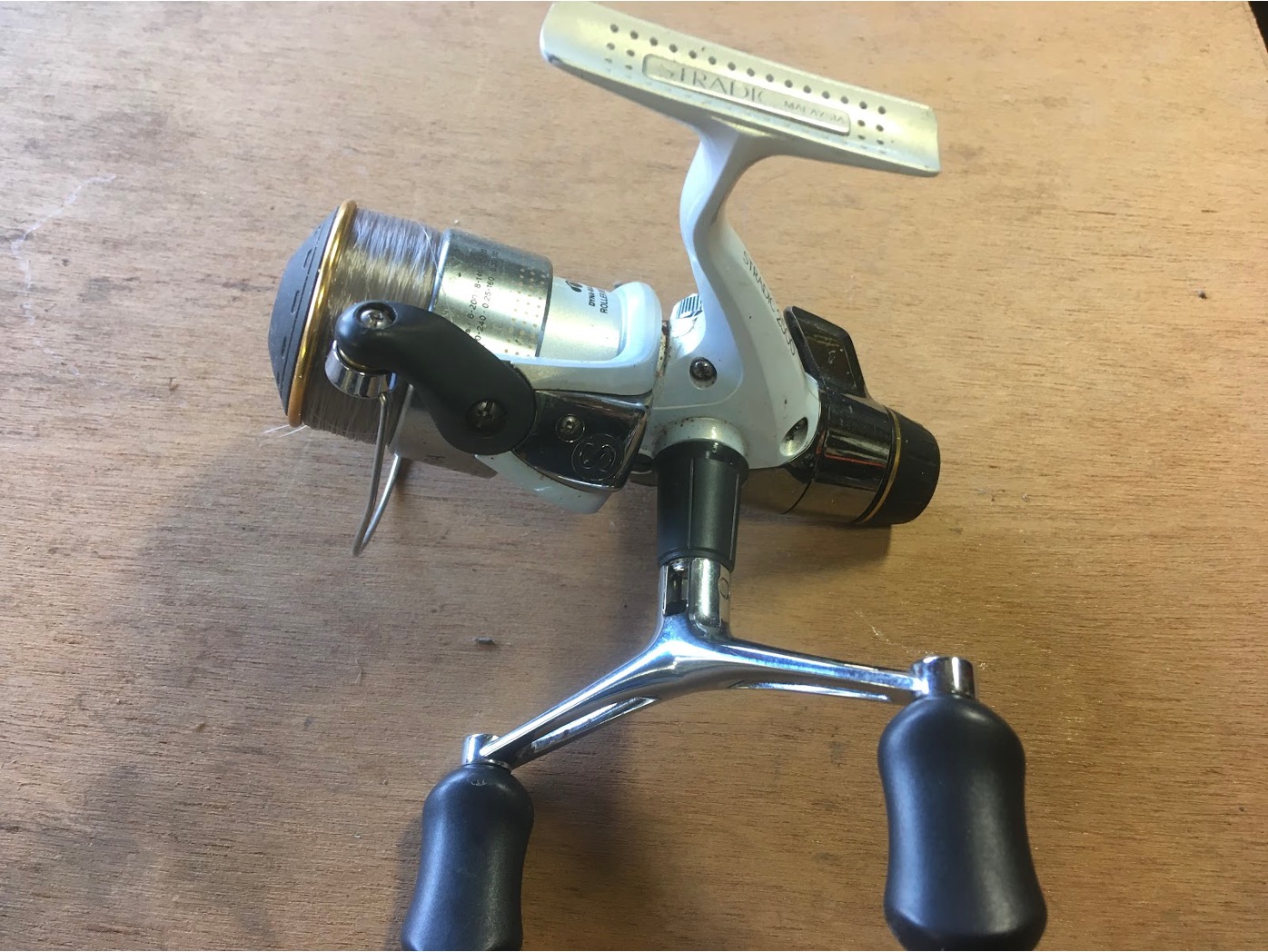
The one that got away. A fine looking reel at a very decent price. Unfortunately this is one of my failures as the reel very quickly developed an internal issue. Did the vendor know there was an issue? We will never know. I am off to dismantle this fine piece of engineering to see if I can return it to its former efficiency. Wish me luck.
- If the reel looks like it has been cared for it is always a bonus, but don’t get carried away..
- Why is the vendor selling it? Is there a problem?
- Don’t be swayed into paying more for having line on the spool. Insist that you will want to replace the line anyway.
- Is there a spare spool?
- Is it boxed with the paperwork? The parts list is useful if you need to buy spares.
- Does the spool oscillate correctly with good line lay?
- Is the handle too loose in the winding position?
- Does the spool release ok? Take it off and check.
- Is the line clip functional?
- Does the reel backwind correctly? Beware, many Shimano reels for example are no longer designed with this facility so if it is important to you buy a different model.
- Does the main clutch work correctly and smoothly?
- If it is a baitrunner does the baitrunner function switch on and off correctly?
- Does the baitrunner clutch also work?
- Does the handle fold away?
- Does the bale arm operate satisfactorily?
- Is the bale arm sloppy in its closed position?
- Ask if the reel has been serviced and cleaned regularly. There is no harm in asking.
I own many second hand reels. I find it hard to resist buying a reel when I can get it at the right price and I can declare, hand on heart, that the vast majority of my purchases have been justified. Having an engineering background gives me a little extra confidence because as long as I can get the parts I feel that I can probably fix any problems I come across. However, just occasionally I do make a mistake.
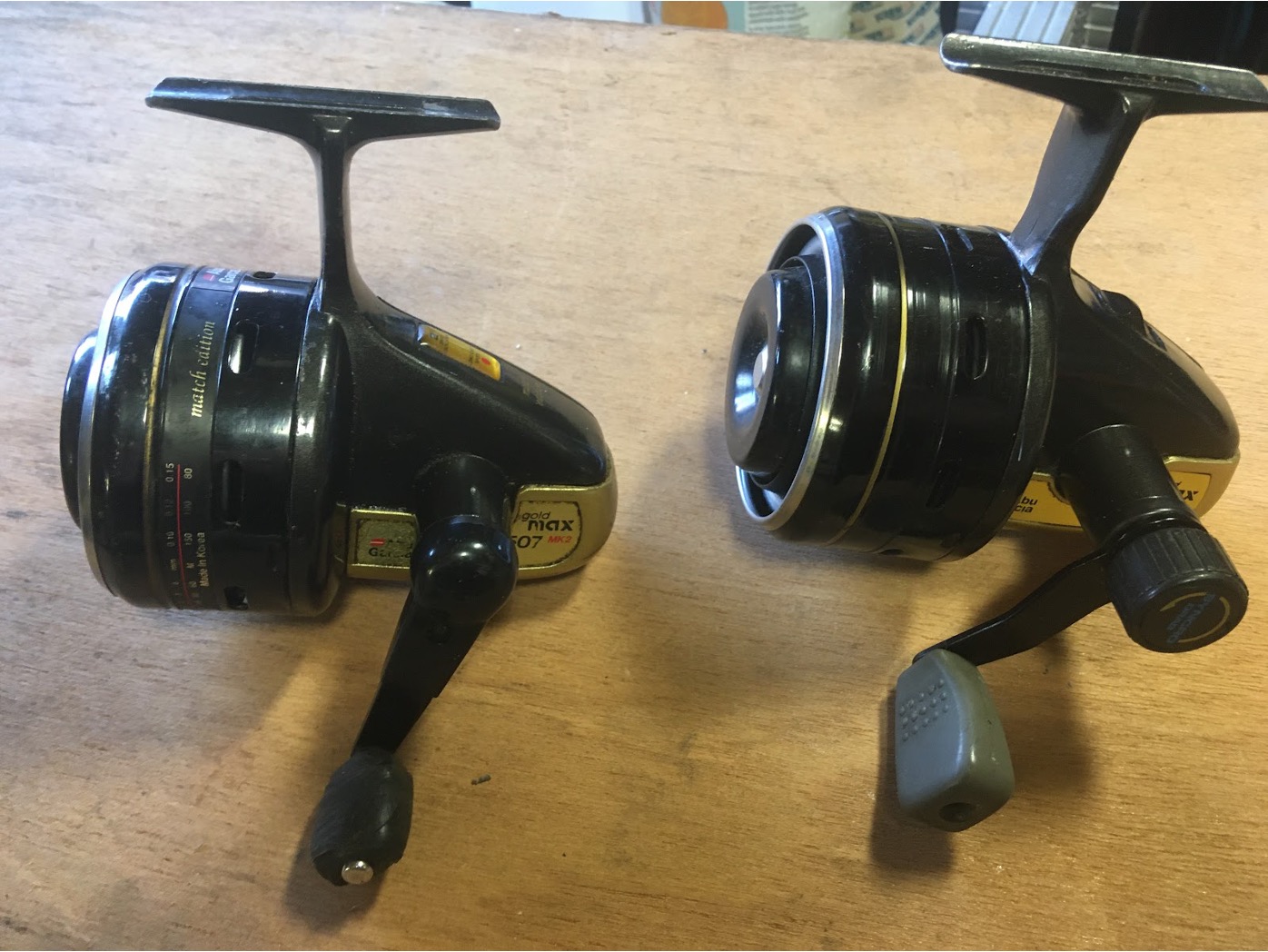
I love Abu Goldmax reels. I bought two brand new ones when they first came out in the nineties (I think) and I now own five or six others, all purchased second hand. They are most certainly not a bad second hand purchase, in my opinion, as despite being a little bit heavy they are by far the best closed-face reels you can buy.
I must admit that the reels in the photograph have a flaw or two, but that makes them an absolute bargain if you know how to repair them quickly and cheaply, which I do. Most vendors don’t seem to understand the way they work and consequently how they fail, and so sell them cheaply in frustration. The subject of how to repair these reels is, unfortunately, a story for another day.
A cautionary tale
One of my most recent purchases was made earlier this year. I purchased a Shimano Stradic 2500 GTM RA that looked to be in perfect condition. The paint finish on the body is beautiful and the two spools are still pristine with all the printing intact and fresh.
It worked like a sewing machine and the bale arm was positive and solid. It came in its original box with the original paperwork and I only paid £42 for it from good old eBay. I felt there was no particular reason for the cheap price other than the seller was disposing of three identical reels and this was the first to go. The other two reels sold just a few moments later for somewhere between £70 and £80 each as the buyers went into a ‘feeding frenzy’ after seeing the first one go for peanuts.
So, I was well pleased with my genuine bargain. I used it for the first time in August when it performed perfectly on a day when I had a great session catching roach and tench on the slider. I had a couple of tench in the 5lb – 6lb bracket and the reel worked fine. “What a good buy” I thought to myself.
I recently used the same Stradic for just the second time, again on the waggler, but this time on a day out where I hooked and landed 58 carp. The average carp was 5lbs and I had several that were approaching double figures. I played and lost another six fish, losing them in a snag right in front of me. There was some heavyweight cranking going on but I wasn’t worried because I have another identical Stradic that has performed beautifully many times, on the same water, catching the same sized fish.
During that session, however, my bargain second hand Stradic reel began playing up and I found it was locking up in a certain spot during the retrieve. I got over the issue by just slightly rotating the bail arm manually which immediately freed up the mechanism to go again. Despite this ‘work-around’ on the bank, this was not a reel I was going to use again unless I fixed it.
It was only a little after this event that I learnt that the parts for this particular reel are no longer available and fixing it may be very difficult. The way the reel locked solid when under pressure made me wonder if the vendor had experienced a similar issue and decided to dump the reels onto someone else. So, my point is this, don’t listen to me! What do I know about buying second hand reels, eh?
#5 Miscellaneous
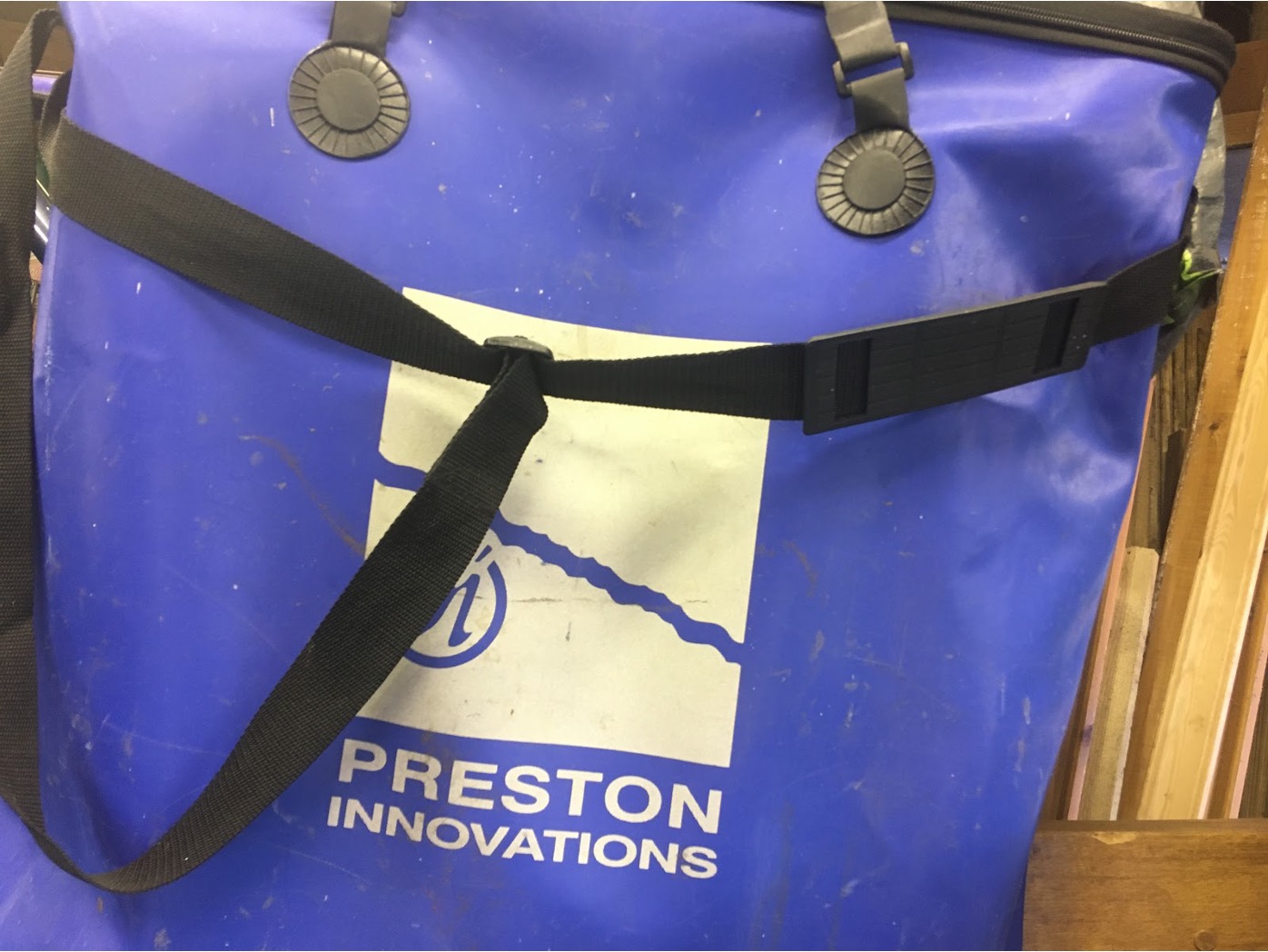
Stuff like this EVA bag are great things to buy secondhand. They are as tough as old boots and providing they are in decent enough condition aesthetically you cannot go wrong. Oh, just to be clear, fill the bag with water to make sure there isn’t a pinhole leak somewhere. You know it makes sense, who wants a leaking net bag?
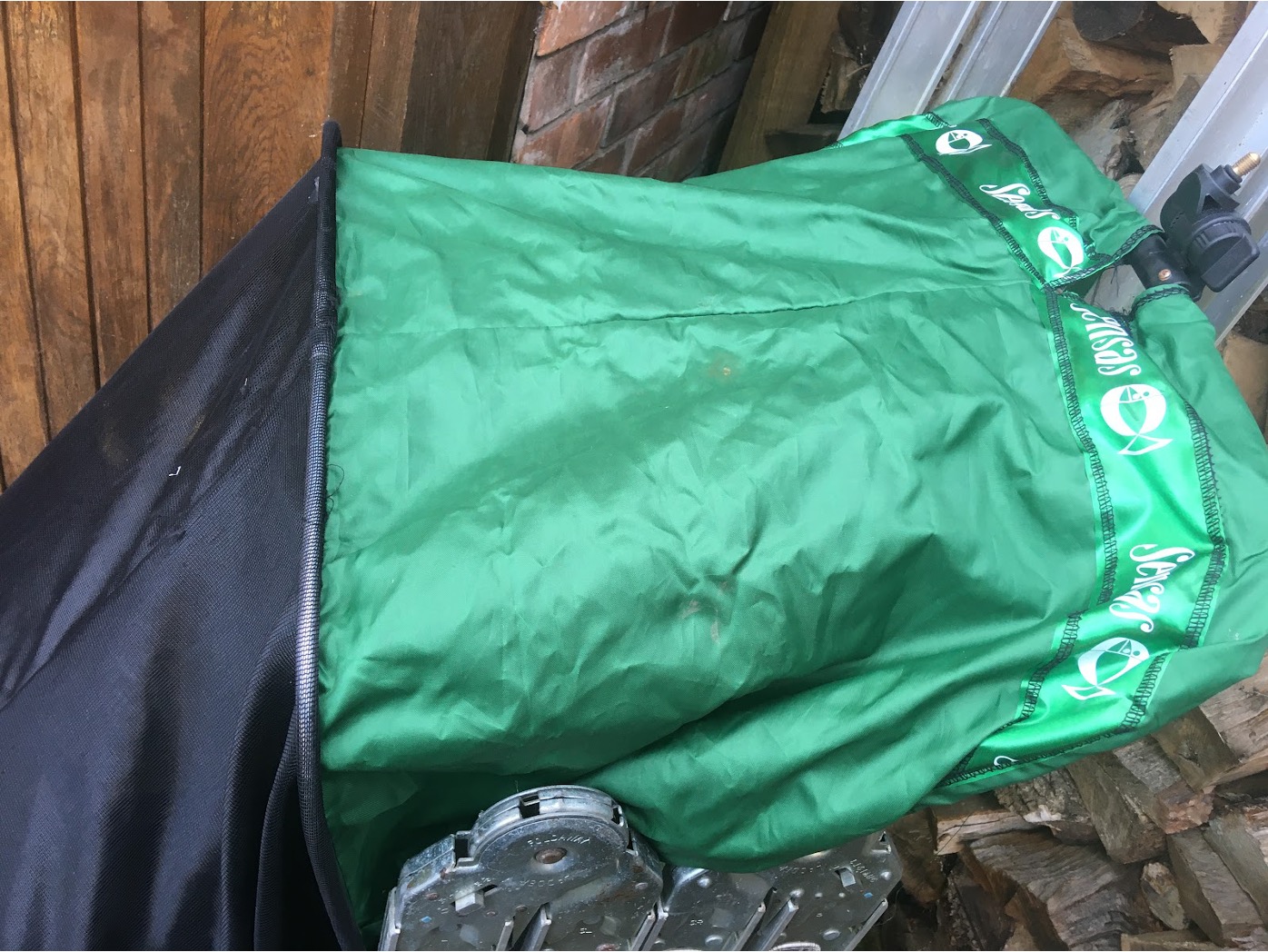
A bargain from Facebook marketplace this time. A Sensas 3m keepnet. Brand new, and in perfect condition for £10. What more needs to be said?
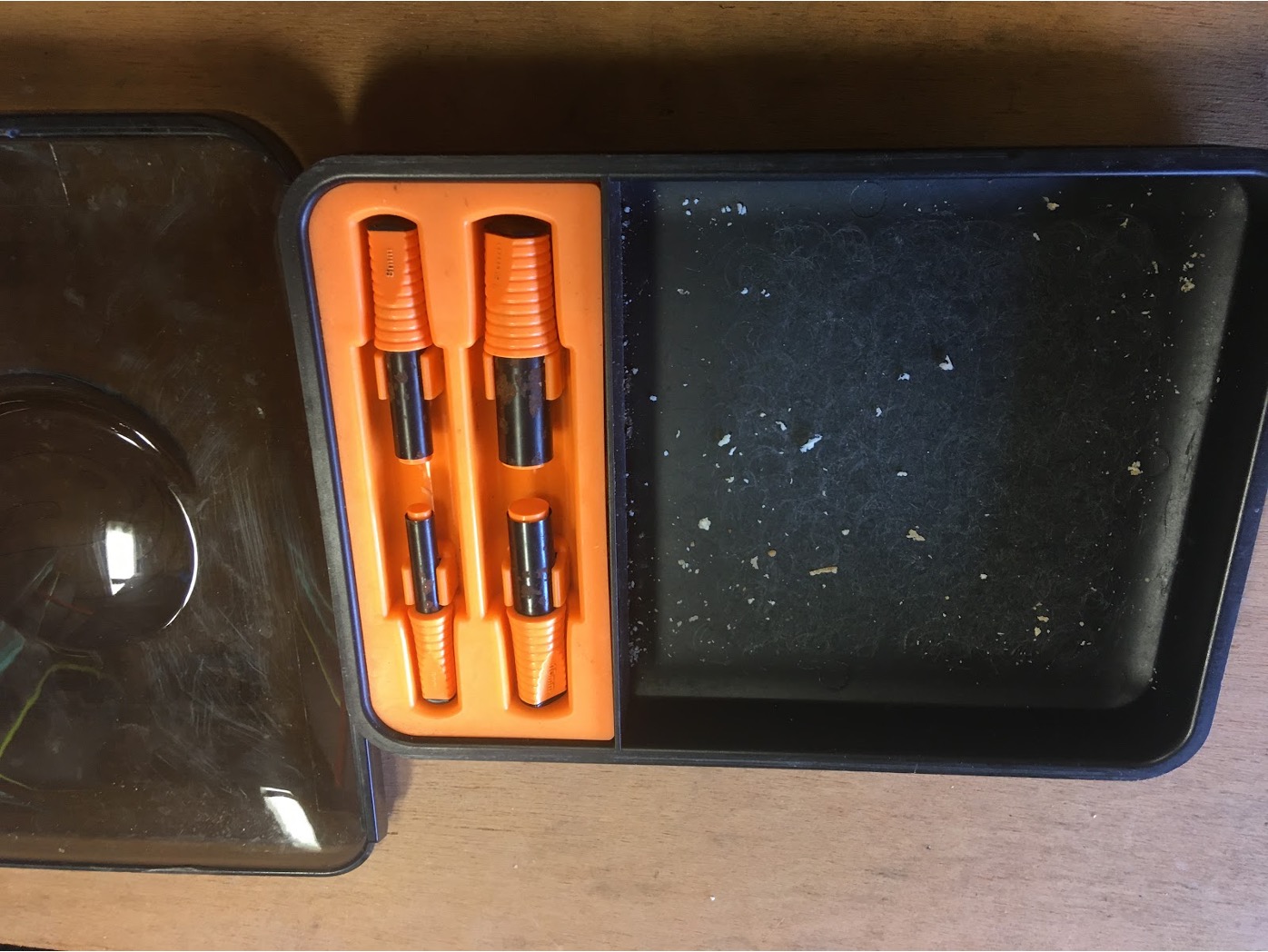
I bought this Guru bread punch kit for ten quid. There was no evidence that it had ever been used when I bought it. I have had this for a few years now and my regular use is written all over it, which is how I know it was probably unused when I bought it. Bargain!
FAQs
Q.
I never seem to win when I bid on an eBay auction. I am frightened to bid too much in one go, preferring to see how much an item is likely to go for and then deciding. Am I doing it right?
A.
Possibly not. The eBay system is not like a live auction that you may have seen on telly, or one you have actually attended. You could potentially bid a million quid on an eBay auction but eBay will only charge you the value of the second highest bidder plus the appropriate increment.
The appropriate increment is the amount that bids must increase to be valid. To save time, and reduce computer-processing delay, very small increases in bids are not allowed. You cannot offer just a penny more, for example, your bid would simply be ignored. On very low price items you may be able to bid in just 50p increments (ie. your bid must be at least 50p higher than the current winning bid). For higher value items the next category will be increases of £1 and so on.
So, if the next highest bidder to you offers £4.50 for example, eBay will recognize your intention to bid up to a million pounds, and make you the current winning bidder at just £5. That will be all you pay unless someone else outbids that amount at which point you will again become the highest bidder for the value of the second highest bid plus the appropriate increment.
Just because your highest bid is £1 million doesn’t mean that’s what you pay. However, if some other misguided fool bid £999,999 then you would actually win the auction with your £million!
So, think carefully before offering anything, then decide what you are truly prepared to pay and bid it, letting the eBay system work it out for you. If you only think the item is worth £5.50 to you then absolutely definitely do not bid any higher. If you lose it is because someone else thought the item was worth more then maybe they were being an idiot whilst you were being sensible. You decide.
Q.
Is there a clever way to win more eBay auctions?
A.
There is no way to guarantee that you will win an auction, other than to bid more money than everyone else. Unfortunately, outbidding everyone else is a recipe for financial disaster so I don’t recommend that anyone to just throw money at the problem.
The most important thing to do when planning a purchase is your homework. Don’t bid on the first thing you see. Check out the prices over a few days or even weeks and understand what is likely to be the winning bid. Decide how much you want to pay as a maximum bid and never bid more than that.
There are a few ‘tricks’ that you can apply to slightly improve your chances but experience will teach you them. If I told you all those ‘tricks’ here and now you might go and tell everyone else in the whole wide world, and spoil it for all of us. It’s not rocket science, but it does require a bit of thought and a bit of discipline. Come round for a cuppa one day and I will spill the beans.
Q.
Can I cancel an eBay bid if I made a mistake even though I won the auction?
A.
Yes you can. There is always potential to ‘click’ on something to make a purchase, only to have a family member enter the room with the same item five minutes later as a surprise gift, but I wouldn’t do it too often or your account is likely to be cancelled.
The feedback system in eBay is a bit of a pain but it does eventually reveal the people who ruin things for everyone else. It is tremendously irritating to all the others who may have bid on an item for someone else to win the auction only to cancel the bid or in some cases just not pay.
I will remind readers that you should always ensure that you have done your homework before the auction, and that you only ever bid whatever you can truly afford. Do both of those things and there should never be any reason to have to cancel a bid. Oh, and don’t go on eBay when you are wearing your beer goggles! Sound advice that.
Conclusion
I am living embodiment of the fact that buying second hand is a perfectly sensible and advantageous thing to buy fishing tackle. I freely admit it is not for everyone and if that’s you then that’s great, with you not bidding that makes it easier for me. When buying second hand you will always make the odd mistake, so be prepared for that. Try to make your mistakes on cheaper items and that way you won’t be put off for life. Do your homework and make sure you understand what kind of money the items you want to buy should command.
I have a friend who once bought a load of small rugs from a High Street shop that had a special offer on them. He then sold the rugs individually at an old fashioned ‘put your hand up and bid’ auction for ridiculous profits. They looked ‘ethnic’ and ‘handmade’ but were really mass produced in China, and my friend made no effort to point out the truth because he didn’t have to.
So, just like in ‘Only Fools and Horses’, remember that there is one born every minute. Make sure that one ain’t you and you will be fine.
Similar articles

In Memory of Peter Cliff
It is with heavy hearts that we announce the passing of Peter Cliff, the founder of Fisheries.co.uk, who passed away in May 2025. Peter’s vision and dedication transformed what began as an idea 26 years ago into one of the…
River Fishing – A guide to getting started
Are you thinking of going for a trip to the river in 2025 but find yourself filled with trepidation because you have never fished running water before? Well I want you to relax. Let us take the mysteries out of…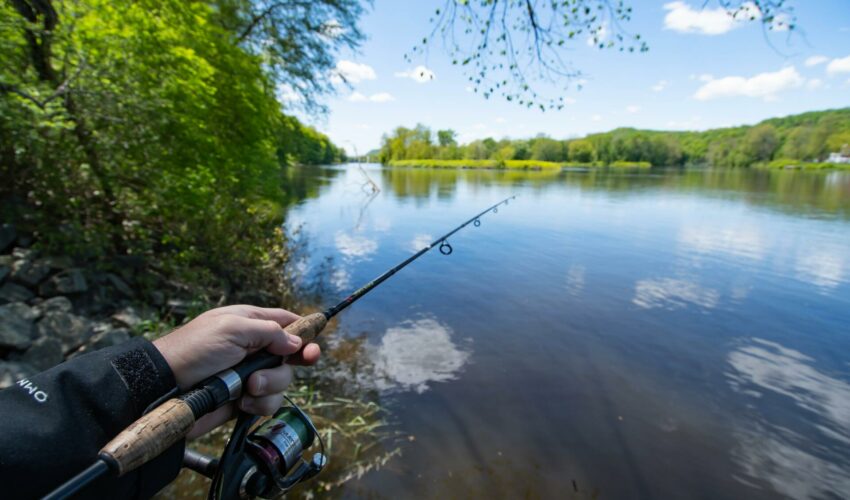
A guide to fishing licences in 2025
Whether you want to become a new angler or you’ve been fishing for years, you will be required to obtain the Environment Agency Rod Licence. In this article we explain what you’ll need if you want to go fishing in…
Make the most of the 2025 river season with this in-depth guide to fishing rivers
If you’re new to fishing rivers, or just fancy a change from fishing stillwaters, this guide will help you make the most of the new 2025 river fishing season. With advice on reading the water, what species to fish for…
Our guide to fishing this spring (2025)
With the worst of the weather over (we hope!) and with spring finally here, it’s time to clean out that tackle box and get on the bank for some spring time fishing.
Take a friend fishing
Get ready to hit the water! From April 18th to May 4th, 2025, you can get a free fishing license to take a buddy out and show them what fishing’s all about. Yep, free! It’s all part of the “Take…Search by Region or County
Find new places to go fishing in your local area or county by choosing your destination below
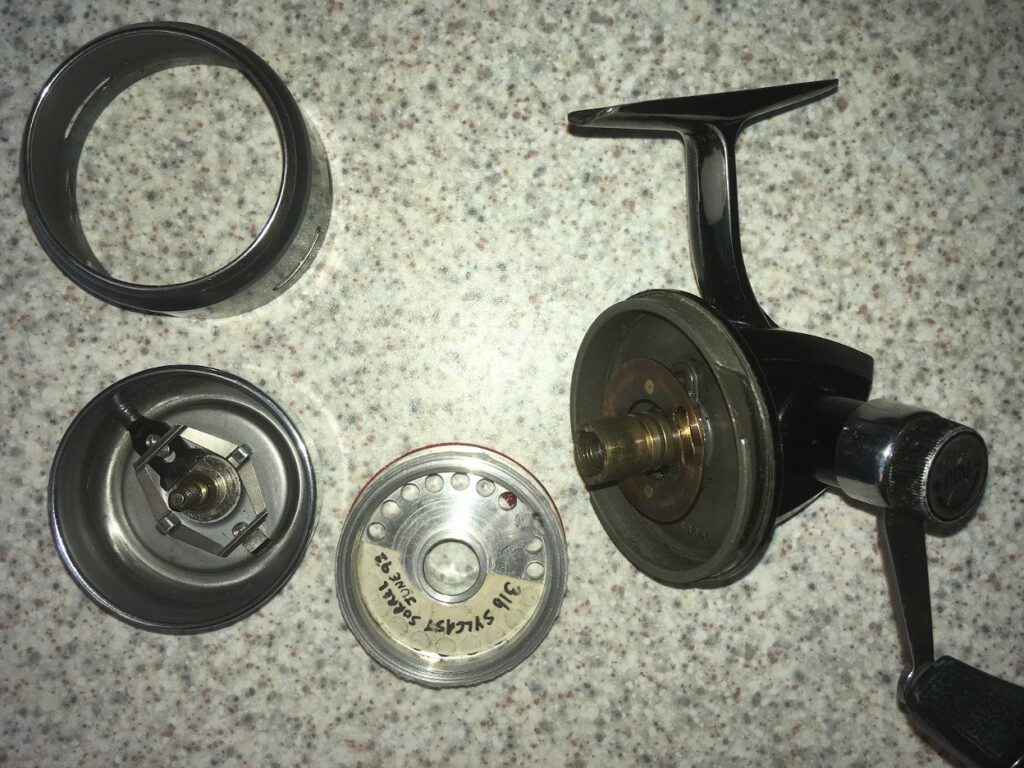








Comments